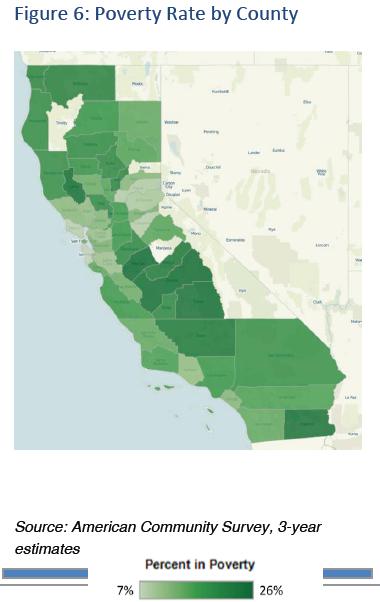“ Our leaders …can start by recognizing that childhood poverty is just as important to our state’s economic growth as creating new jobs,…”
Ann O’Leary challenges California to face up to the problem of childhood poverty in a Sacramento Bee opinion piece, We can’t abandon the next generation. She marshals sobering statistics about the Great Recession’s legacy of impoverishment and suggests some approaches to deal with it.
The Great Recession led to record setting levels and rates of poverty in California;
- According to the Census Bureau’s official estimates, “more Californians are living in poverty – 6.3 million – more than at any point since the U.S. census started tracking state poverty”
- If that weren’t bad enough, the Census Bureau’s new Supplementary Poverty Measure (see description and county poverty rates below) “puts the number of Californians in poverty at 8.7 million” which means that California has “the highest poverty rate in the country.”
- Almost half of all California children live in or very nearly in poverty.
- “more than twice as many California children live in poverty as seniors”, 21 percent of children versus 8.5 percent of seniors.
Not surprisingly, childhood poverty is greatest in areas of high unemployment, low rates of medical insurance coverage, high percentages of single-parent households, and low educational attainment rates. According to Prosperity Threatened: Perspectives on Childhood Poverty in California, by The Center for the Next Generation childhood poverty in by the Supplemental measure in 2011 was highest in Lake County at 37.9 percent, followed by Merced County, 36.0 percent, and Fresno County at 35.0 percent.
To address this, O’Leary recommends increasing school funding in high child poverty areas and making it easier for poor families to access healthcare and to the existing range of income security programs.
Note: according to the Governor’s 2013-14 Budget Proposal: “School districts serving those students who have the greatest challenges will receive more generous increases — so that all students in California have the opportunity to succeed.”
Source: Prosperity Threatened: Perspectives on Childhood Poverty in California
Supplementary Poverty Measure
According to the Census Bureau’s Supplementary Poverty Measure, the poverty rate in California is the highest in the nation, 23.5 percent. Only Hawaii and the District of Columbia come close.
The Supplemental Poverty Measure differs from the official measure in that it (1) accounts for government benefits and taxes, work expenses (including childcare), and medical expenses on households’ standards of living and (2) uses a more accurate measure of the poverty line. The official poverty measure’s poverty lines are based on surveys of family expenditures from the 1950s, whereas the supplemental measure’s poverty lines are based on actual expenditures on food, clothing, shelter, and utilities. Also, the Supplemental poverty line takes into geographic differences in housing prices.



It sounds like you are saying children are the biggest victims of the state’s policies that raise housing and utility costs.
Elders suffered less in the recession than families because they are less dependent on wage income. That doesn’t mean they’re rich, as anyone who has examined the Social Security statistics would recognize. But the more important problem is that poor children come along with poor parents, and that the problem of child poverty will only be alleviated when the government recognizes that funding education is not the only necessity.
And in California the first and foremost problem is that of affordable housing for the poorest third of the population. Our state and local governments have failed to produce even a small percentage of the housing necessary to protect families from rapacious landlords who can make substantial income from hovels because low-income families have no other options. A third of students in Los Angeles change schools every year, not because of the schools, but because their parents can’t maintain their housing.
In some ways the proposed budget makes the problem worse. Single mothers can’t keep their jobs without subsidized child care, as their jobs pay less than they would have to pay for market-rate placements. Taking the redevelopment money earmarked for low-income housing means that there will be no new housing for families in poverty. (Note that I am not opposed to taking the money earmarked for auto malls, cutesy shopping districts and the like.)